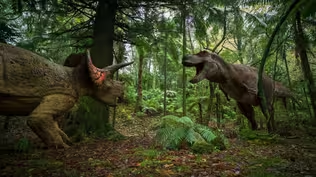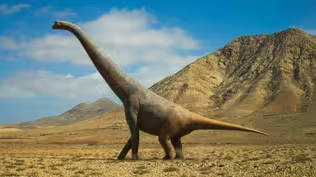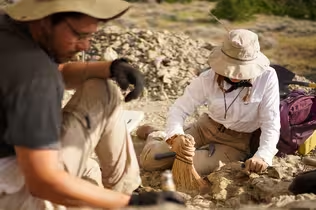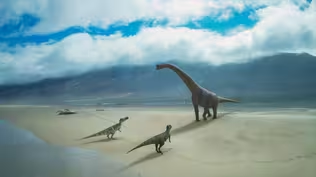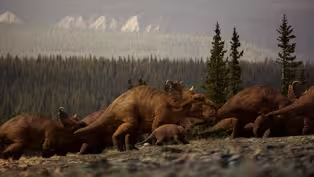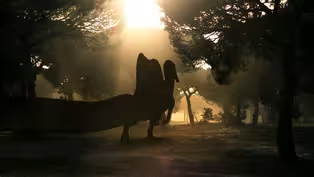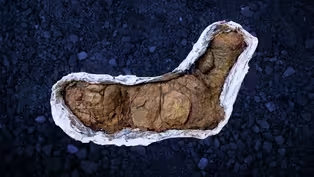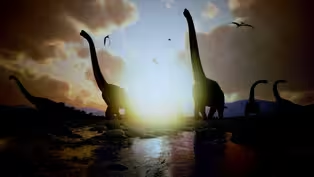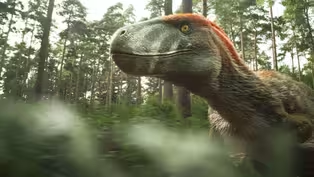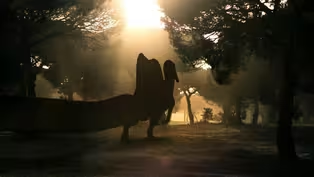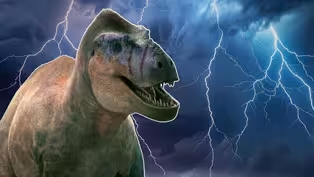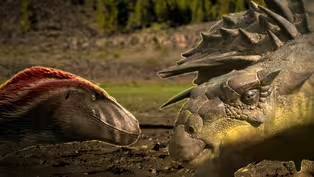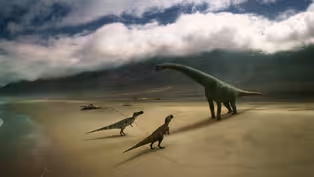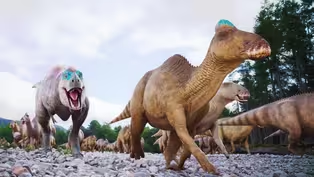
Were Dinosaur Brains Designed For Combat?
Special | 5m 42sVideo has Closed Captions
Did Pachyrhinosaurus bones always gather in such great numbers?
The thousands of Pachyrhinosaurus bones found at Pipestone Creek suggests that these animals lived together in herds. But did they always gather in such great numbers? To find out, scientists have taken X-rays of the skulls of these dinosaurs to see if their brain was suited to living in herds. The results shed light on this question and reveal how well adapted their skulls were for combat.
Problems playing video? | Closed Captioning Feedback
Problems playing video? | Closed Captioning Feedback
Narrator: Bertie Carvel With Thanks: Philip J Currie Dinosaur Museum, Alberta Parks, Alberta Dig Team, County of Grande Prairie, Municipal District of Greenview Digital Producer & Director: Mark Atwill Digital...

Were Dinosaur Brains Designed For Combat?
Special | 5m 42sVideo has Closed Captions
The thousands of Pachyrhinosaurus bones found at Pipestone Creek suggests that these animals lived together in herds. But did they always gather in such great numbers? To find out, scientists have taken X-rays of the skulls of these dinosaurs to see if their brain was suited to living in herds. The results shed light on this question and reveal how well adapted their skulls were for combat.
Problems playing video? | Closed Captioning Feedback
How to Watch Walking with Dinosaurs
Walking with Dinosaurs is available to stream on pbs.org and the free PBS App, available on iPhone, Apple TV, Android TV, Android smartphones, Amazon Fire TV, Amazon Fire Tablet, Roku, Samsung Smart TV, and Vizio.
Providing Support for PBS.org
Learn Moreabout PBS online sponsorshipMore from This Collection
Check out our 12 digital exclusives from our series Walking with Dinosaurs with BBC.
When Dinosaurs Ruled the Arctic Circle
Video has Closed Captions
Very few dinosaurs made it as far North as the Arctic Circle...except for two. (5m 52s)
We Were Wrong About Spinosaurus
Video has Closed Captions
Millions of years ago, dinosaurs ruled the Earth. But underwater it was a totally different world. (6m 36s)
How We Solve Jurassic Mysteries from One Bizarre Fossil
Video has Closed Captions
Would you lick a 65-million-year old dinosaur poop? (5m 19s)
How Walking with Dinosaurs Created the Most Accurate Dinos Ever
Video has Closed Captions
Join the team behind the scenes! (6m 32s)
How to Find a Dinosaur that Hollywood Dreamed Up
Video has Closed Captions
What would make a Utahraptor so much larger than other raptor species? (5m 50s)
How the Walking with Dinosaurs Team Brought a Dinosaur Back to Life
Video has Closed Captions
The Walking With Dinosaurs team reveal how they created the Spinosaurus. (5m 50s)
How Extreme Weather Is Revealing — And Destroying — Dinosaur Fossils
Video has Closed Captions
Imagine finding a rare fossil that you’ve been desperate to find - only for it to be put at risk. (5m 59s)
How an Evolutionary Arms Race Created Bizarre Dino Designs
Video has Closed Captions
It’s grudge match time. Except that this one took place over millions of years. (5m 32s)
The Dinosaurs that Could Cross the Atlantic
Video has Closed Captions
How did dinosaur fossils get there? (5m 42s)
Did Dinosaurs Abandon Their Young to Help Them Survive?
Video has Closed Captions
In late Cretaceous Alberta, many apex predators roamed free, so how did the prey survive? (5m 45s)
Did a Meteor Kill All the Dinosaurs?
Video has Closed Captions
Did the asteroid kill the T. rex and Triceratops? (5m 42s)
Providing Support for PBS.org
Learn Moreabout PBS online sponsorship[metallic tapping against rock] -[Narrator] In the wilderness of Northern Alberta, scientists are excavating the bones of the unique horned dinosaur, Pachyrhinosaurus.
In an effort to do something truly unexpected, reconstruct their brains.
Surveys of the ancient rock in Pipestone Creek show its home to one of the biggest dinosaur herds ever found.
With the Pachyrhinosaurus living in colossal groups.
-[Emily Bamforth] It could be literally hundred of thousand maybe even millions of bones and so we estimate the size of the Pipestone Creek herd at 40,000 animals.
-[Narrator] So what enabled these one and a half ton herbivores to live in such enormous numbers, seventy-three million years ago?
To find out, paleontologist Emily Bamforth wants to get inside their heads.
-[Emily] Even though the brain is long gone, [deep bellowing] if we look into the, the skulls of these long extinct animals, what could better help us understand what the structure of herding animal brains actually looks like and how that might have informed the behavior of the animal.
-[Narrator] Pachyrhinosaurus brains were protected by a thick solid shell known as the brain case.
Today, Emily is bringing one of these brain cases, still inside a skull to a specialized imaging facility in Edmonton, Alberta.
She’s investigating a theory that the brains of herding dinosaurs would be physically different to those that were on their own.
Because of the demands of living in a group.
-[Emily] Herding dinosaurs versus solitary animals might have various parts of the brain that are developed differently because they need to focus on certain behaviors over others.
-[Narrator] So to understand more, she’s using a CT scanner normally reserved for human patients to create x-ray images of the shape inside the brain case.
-[Emily] CT scanning gives us a really clear idea of what the shape of the internal bones are.
The brains themselves are not preserved, what we get is the space in the skull where the brain was.
-[Narrator] Once the scan is completed, scientists Max Scott and Natalia [indistinct] can use the images to reconstruct the brain’s shape.
It’s a painstaking process, tracing the shape slice by slice to build a full 3D model.
-[Max] You can see the brain structures, there’s a lot of, lot of density in here, just all really great things.
-[Narrator] It paints a clear picture of how Pachyrhinosaurus brains were adapted to life in the herd.
-[Emily] They have structures in their brains that are found in herding animals today.
Things they probably would have used for individual identification.
-[Narrator] Pachyrhinosaurus herds are thought to have consisted of thousands of smaller family groups, so they had to be able to spot each other in a crowd.
And the scan suggests parts of their brain was specialized to identify each individual’s unique frill.
-[Natalia] There’s structures and they’re closely associated with pattern recognition.
-[Emily] Every frill is different and parts of the Pachyrhinosaurus brain are better developed so they can recognize each pattern.
At a distance they could see who was who.
-[Narrator] But the results also show their brains were adapted for more than finding friends.
They were built for dealing with foes.
Living in large social groups meant that the males had to fight for the pick of the mates and Pachyrhinosaurus brains appear to be wired for handling these one-on-one battles.
-The vestibula apparatus is rather enlarged and it’s what strongly controls that eye stabilization so they’re able to track movements around them.
-[Emily] The organ that is used for, for balance seems to be more developed in Pachyrhinosaurus.
Having good balance would be a better way to withstand individual to individual combat which would be more common in a herd environment.
[guttural grunt] -[Narrator] For Emily and her team, this cutting-edge research has given them new insight in to these unique dinosaurs.
And with more discoveries being made all the time it’s revealing an unprecedented picture of what life was life in one of the biggest dinosaur herds in Earth’s history.

- Science and Nature

Explore scientific discoveries on television's most acclaimed science documentary series.

- Science and Nature

Capturing the splendor of the natural world, from the African plains to the Antarctic ice.












Support for PBS provided by:
Narrator: Bertie Carvel With Thanks: Philip J Currie Dinosaur Museum, Alberta Parks, Alberta Dig Team, County of Grande Prairie, Municipal District of Greenview Digital Producer & Director: Mark Atwill Digital...
